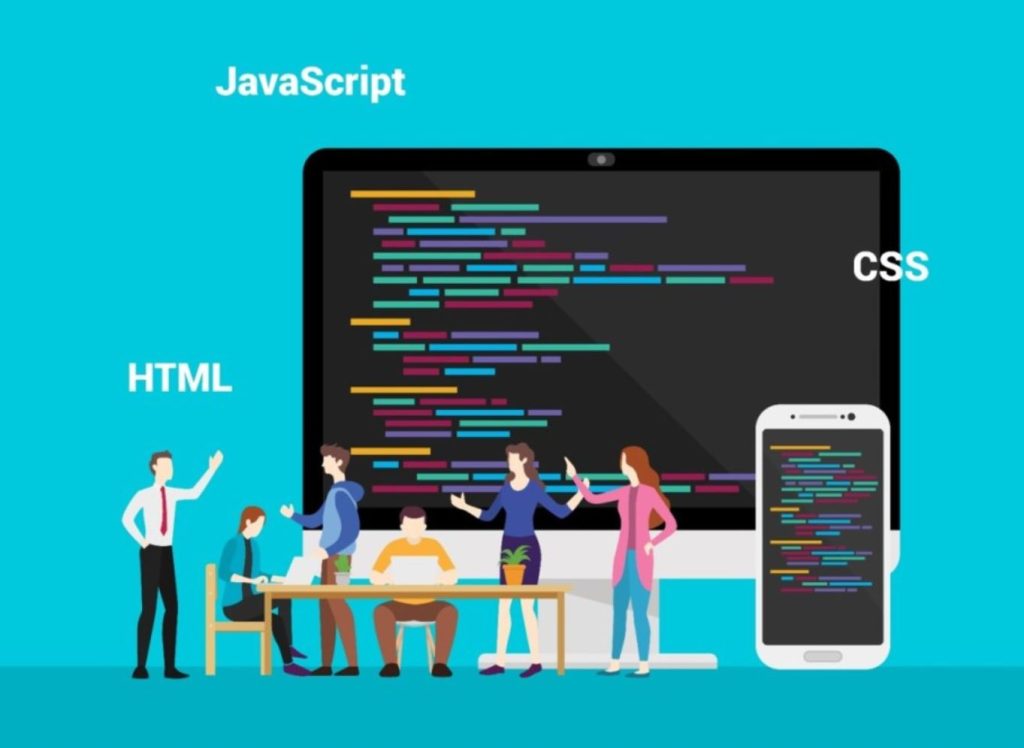Front-end programming, also known as client-side development, encompasses the set of activities and skills involved in creating the visual and interactive elements of a website or web application that users directly interact with. It involves writing code to design and implement the user interface (UI) and user experience (UX), ensuring a seamless and visually appealing interaction.

Key Aspects of Front-End Programming
- HTML (Hypertext Markup Language): HTML forms the backbone of web pages, defining the structure and content. It consists of tags that organize and present information, such as headings, paragraphs, images, links, and more.
- CSS (Cascading Style Sheets): CSS is used to style HTML elements, providing control over the layout, colors, fonts, and overall visual presentation of a website. It enables developers to create a consistent and aesthetically pleasing design.
- JavaScript: JavaScript is a dynamic scripting language that adds interactivity to web pages. It allows developers to create responsive and dynamic elements, such as image sliders, form validation, and real-time updates, enhancing the user experience.
- Responsive Design: Front-end developers need to ensure that websites are responsive, meaning they adapt to various screen sizes and devices. This involves using CSS media queries and flexible layouts to create a seamless experience across desktops, tablets, and mobile devices.
- Frameworks and Libraries: Front-end developers often use frameworks and libraries to streamline development and enhance functionality. Popular choices include:
- React.js: A JavaScript library for building user interfaces, often used for single-page applications.
- Angular.js: A comprehensive front-end framework developed by Google, suitable for building dynamic web applications.
- Vue.js: A progressive JavaScript framework for building user interfaces, known for its simplicity and flexibility.
- Version Control/Git: Front-end developers commonly use version control systems like Git to manage and track changes in code collaboratively. This ensures a systematic approach to development, allowing teams to work seamlessly.
- Web Performance Optimization: Optimizing the performance of web pages is crucial for a positive user experience. Front-end developers focus on reducing page load times, minimizing the use of large media files, and employing techniques like lazy loading to enhance website speed.
- Browser Developer Tools: Familiarity with browser developer tools is essential for debugging and optimizing code. Developers use these tools to inspect and modify HTML, CSS, and JavaScript in real-time, making it easier to identify and fix issues.
- Cross-Browser Compatibility: Ensuring that a website functions correctly across various web browsers (Chrome, Firefox, Safari, Edge, etc.) is a key responsibility of front-end developers. They address compatibility issues and ensure a consistent experience for users regardless of their chosen browser.
- Collaboration and Communication: Front-end developers often collaborate with back-end developers, designers, and other team members. Effective communication and collaboration skills are essential for successfully implementing a cohesive and functional web application.
Pros and Cons of Learning Front-End Programming
Learning front-end web development comes with its set of advantages and challenges. Here are the pros and cons of delving into front-end web development:
Pros in Learning Front-End Programming
- High Demand for Skills:
- Pro: There is a consistently high demand for skilled front-end developers as businesses seek to enhance their online presence and user experiences.
- Quick Visible Results:
- Pro: Front-end developers often see immediate results of their work, as changes to the user interface are directly visible.
- Creative Expression:
- Pro: Front-end development allows for creative expression, as developers design visually appealing and user-friendly interfaces.
- Dynamic Field:
- Pro: The front-end development field is dynamic and evolves rapidly, providing opportunities to work with new technologies and tools.
- Freelance Opportunities:
- Pro: Many front-end developers work as freelancers, offering flexibility in work arrangements and project choices.
- Community and Resources:
- Pro: There is a robust online community and numerous learning resources, making it easier for beginners to access support and stay updated with industry trends.
- Transferable Skills:
- Pro: Front-end development skills can be transferable to related roles, such as UI/UX design or full-stack development.
Cons in Learning Front-End Programming
- Constant Learning Curve:
- Con: The fast-paced evolution of front-end technologies requires continuous learning to stay relevant in the field.
- Browser Compatibility Issues:
- Con: Front-end developers must address and debug compatibility issues across various web browsers, which can be time-consuming.
- Dependency on Design Skills:
- Con: While design skills can enhance a front-end developer’s profile, not everyone has strong design abilities, and collaboration with designers may be necessary.
- Limited Control Over Back-End:
- Con: Front-end developers primarily focus on the user interface and may have limited control over server-side operations, which are handled by back-end developers.
- Job Scope Overlap:
- Con: The line between front-end and full-stack development can blur, leading to potential overlap in responsibilities, especially in smaller teams.
- Security Challenges:
- Con: Front-end developers need to be vigilant about security concerns, but the primary responsibility for server-side security often falls on back-end developers.
- High Competition:
- Con: The popularity of front-end development has led to high competition in the job market, requiring developers to differentiate themselves through additional skills or specialization.
- Technology Fatigue:
- Con: The frequent release of new tools and frameworks can lead to technology fatigue, with developers feeling overwhelmed by the need to continuously adapt.

Front-end web development offers exciting opportunities for creative expression and career growth. However, individuals entering this field should be prepared for a continuous learning journey and the need to adapt to evolving technologies and industry trends. The pros and cons provide a balanced perspective for aspiring front-end developers to consider.
In summary, front-end programming involves creating the visual and interactive components of a website or web application, using languages like HTML, CSS, and JavaScript. Front-end developers focus on creating an engaging user experience, optimizing performance, and ensuring compatibility across different devices and browsers.
Categories: Tech
Leave a Reply